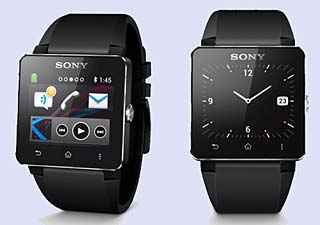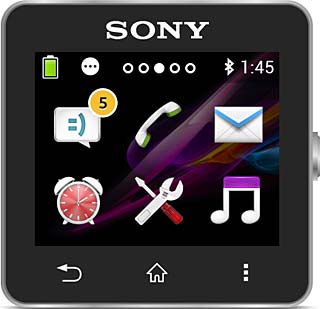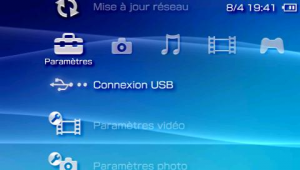Last update : May 28, 2014

Sony SmartWatch 2
The Sony SmartWatch 2, also known as SW2, is a wearable device launched in late September 2013. The SW2 connects to an Android 4.0 (and higher) smartphone using Bluetooth, and supports NFC for easy pairing. The display is a transflective LCD screen with a 220×176 resolution.
Sony SmartWatch 2 Usage

Sony SmartWatch 2 Homescreen
To set up your SmartWatch 2 device, you need first to install the Smart Connect (formerly Liveware Manager) app (last update May 8, 2014) on your phone and to pair it with your phone using a Bluetooth connection. The next step is to install the official Sony SmartWatch app (last update May 6, 2014). This app is not visible in the phone’s home screen, but integrated in the Smart Connect app and in the phone’s status bar. The app allows to edit settings, select a watch interface and to find/enable/disable SmartWatch app extensions.
Sony SmartWatch 2 Extensions
Some useful free extensions for the watch are listed below :
- Calendar, by Codeglam Mobile, April 27, 2014
- GPS Map, by Sascha Löffler, April 17, 2014
- Gallery, by Dynamic Upgrade, May 27, 2014
- Google Voice Search, by Guillaume Ogier, May 9, 2014
- Slideshow, by Square Island, September 22, 2013
Some useful paid extensions are listed hereafter :
- Sphero, by Dynamic Upgrade, January 1, 2014
- Remote Shot, by watea network, March 31, 2014
- Camera Touch, by Shuisky, May 1, 2014
- Calendar, by Shuisky, May 1, 2014
Sony SmartWatch 2 Developement
The Sony Developer World website provides SDK’s, tutorials, tips, tools and documentation how to create SmartWatch 2 app extensions. A comprehensive Knowledge Base is available to provide more informations about these topics.
Sony SmartWatch 2 on Blackberry Z10
To run the SmartWatch 2 application in the Blackberry Android 4.3 Runtime Player, you need to do a small modification in the MANIFEST.xml file of the SmartWatch 2 app and its extensions and to resign the Smart Connect app with the same key. See my separate post about this subject for additional informations.

